Design of Small, Low-Cost, Underwater Fin Manipulator by
advertisement
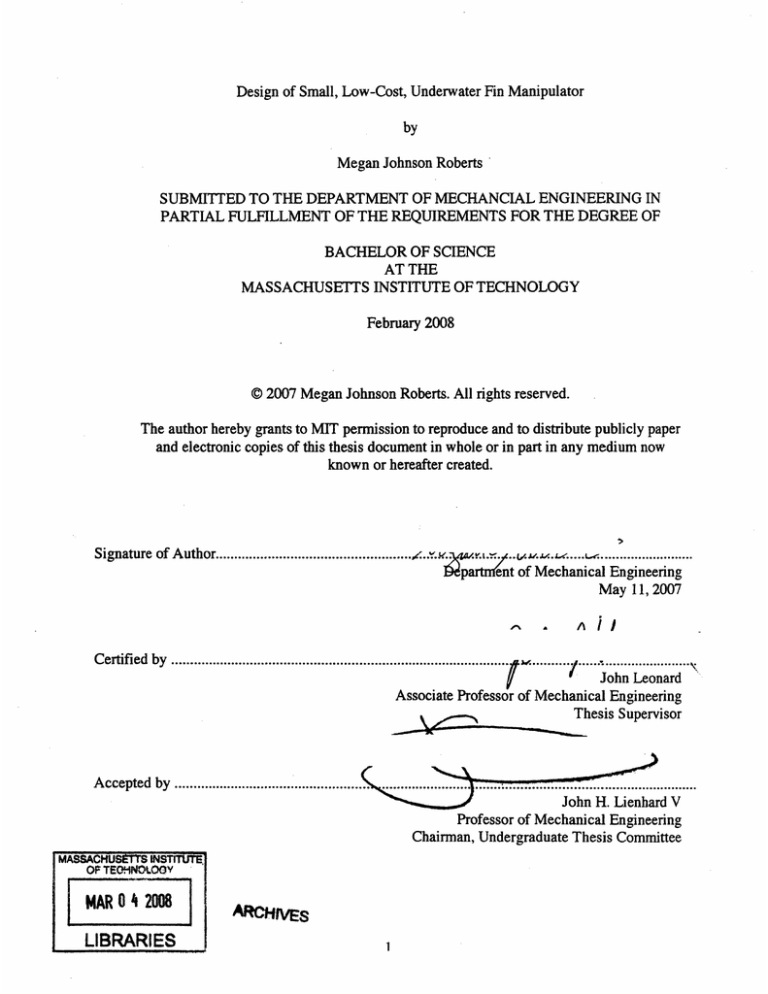
Design of Small, Low-Cost, Underwater Fin Manipulator by Megan Johnson Roberts SUBMITTED TO THE DEPARTMENT OF MECHANCIAL ENGINEERING IN PARTIAL FULFILLMENT OF THE REQUIREMENTS FOR THE DEGREE OF BACHELOR OF SCIENCE AT THE MASSACHUSETTS INSTITUTE OF TECHNOLOGY February 2008 © 2007 Megan Johnson Roberts. All rights reserved. The author hereby grants to MIT permission to reproduce and to distribute publicly paper and electronic copies of this thesis document in whole or in part in any medium now known or hereafter created. Signature of Author.............................. ...,. .. .............................. Dpartnfent of Mechanical Engineering May 11, 2007 A ll C ertified by .......................................................................................... W ........... .............................. John Leonard Associate Professor of Mechanical Engineering Thesis Supervisor Accepted by .................... ..................................................... John H. Lienhard V Professor of Mechanical Engineering Chairman, Undergraduate Thesis Committee MASSACHUSMS INSTitUTE OF TEOHNOLOOY MAR 0 4 2008 LIBRARIES ARCHIVES Design of Small, Low-Cost, Underwater Fin Manipulator by Megan Johnson Roberts Submitted to the Department of Mechanical Engineering on May 11, 2007 in Partial Fulfillment of the Requirements for the degree of Bachelor of Science in Mechanical Engineering ABSTRACT This thesis details the development of a small, low cost, underwater manipulator for use on the XAUV. At this time, there are no cheap underwater servos commercially available. The design involves modifying a commercially available servo so that it is waterproof and can provide the appropriate amount of torque. The manipulator is intended rotate the fins of the XAUV in order to enhance overall mobility and speed. The project includes a detailed design process resulting in a final design, which was built. Thesis Supervisor: John Leonard Title: Associate Professor of Mechanical Engineering Acknowledgements The author would like to thank John Leonard for being the Thesis Advisor, and Dan Walker for his endless help and support. TABLE OF CONTENTS ABSTRACT Acknowledgements List of Figures List of Tables Chapter 1. Introduction 1.1 Actuators 1.2 Previous Work 1.3 Design Goals Chapter 2. Design Process 2.1 Design Concept 1 2.2 Design Concept 2 Chapter 3. Final Design Chapter 4. Design Analysis 4.1 Torque 4.2 Gear Strength 3 5 8 9 11 11 11 12 13 14 16 18 24 24 25 Conclusions 27 Bibliography 28 LIST OF FIGURES Figure 1: The XAUV Figure 2: Cross section of Design Concept 1 Figure 3. Isometric view of Design Concept I Figure 4: Cross Section of Design Concept 2 Figure 5: Isometric view of Final Design Figure 6: Cross-section view of Final Design 19 21 Figure 7. The two pieces of the waterproof ho using 22 Figure 7: Assembly servo, gears, bearings, an d top part of the case 23 Figure 8: Final Assembly Figure 9: Graph showing the Torque-Speed Characteristics of the Hobbico CS-80 servo 24 LIST OF TABLES Table 1: List of Parts 20 Chapter 1. Introduction A majority of the earth's surface is covered by water. Underwater robots can be used to explore areas of the ocean where humans cannot go, due to high pressures, low visibility, and low temperatures. Given the right sensors, these robots can collect a variety of data. There are two common types of underwater vehicles: Remote Operated Vehicles (ROV's) and Autonomous Underwater Vehicles (AUV's). ROV's are operated on a tether (which relays power and information to and from the robot) and are thus better suited for shorter journeys. AUV's operate without a tether and tend to be larger. As a result they are often used in longer missions. AUV's could potentially have applications in ocean exploration, environmental research, military, and other sectors. Unfortunately, AUV's remain expensive. Currently, in order to inspect Navy ship hulls for objects, divers must be sent down to inspect by hand. The MIT Computer Science and Artificial Intelligence Laboratory (CSAIL) is developing autonomous underwater vehicles fitted with sensors to inspect the ship hulls that would eliminate the need for divers. As part of this parent project, the XAUV is designed to be an easily modifiable platform for testing new sensors, control schemes, and mapping algorithms. This thesis project will develop manipulators for the fins of the XAUV. The manipulators are designed to be small, powerful, low cost, and waterproof. Figure 1. The XAUV Eight fins will be arranged on the XAUV. with four in the front and four in the back, which will provide it greater maneuverability and speed. The manipulator developed as part of this project will allow a fin to rotate a span of at least thirty degrees. 1.1 Actuators There are many types of actuators used in robotics, however operating the robot underwater presents challenges that limit the options. Currently, commercially available underwater actuators tend to be big or expensive. A popular type of underwater actuator is the hydraulic actuator. Hydraulic actuators have good depth resistance, however they are big and heavy. The XAUV is not intended for use in very deep water and has limited space. For those reasons, hydraulic actuators were not appropriate for this application. Another common type of actuator is the DC motor, which commonly come as part of an RC servo, available in a wide range of sizes. It is possible to find small, inexpensive servos that are relatively powerful. Commercially available servos are typically not designed for underwater applications, and are thus not made to be waterproof, but it is possible to construct a waterproof housing. Since seal technology is fairly well advanced, creating a well-sealed housing for a nonwaterproof servo is reasonable. Servos also are available in appropriate sizes and can be made waterproof, and for those reasons they were chosen as the actuator in this project. 1.2 Previous Work The RoboPike, developed in MIT's Towing Tank, used a modified RC servo as part of its main body. The project was to create a biomimetic fish in order to better understand how fish propel themselves through the water. The servo was modified to provide linear output motion allowing the fish to flex its body to swim. In 2006, Lauren Cooney developed an underwater robotic arm manipulator for her senior thesis. This arm uses servos to directly drive the joints of the arm. Her design required making a housing in order to seal the servos from the surrounding environment. 1.3 Design Goals The manipulator must be made compact, lightweight, and cheap in order to meet the needs of the XAUV. It is specifically designed for the fins, but could potentially have other uses, too, so it must be designed to easily interface to other systems. 2.0 Design Process The manipulator will use a commercially available servo in order to rotate the fins of the XAUV. The servo chosen for this application is a Hobbico Command Dual BB CS-80. In order to get an appropriate output torque and speed, gears are used to transfer power from the servo to the shaft of the fin. The gears used are spur gears with a ratio of 1:3. Spur gears have a simple geometry, which makes them inexpensive. The gears that were chosen were 32 pitch with a 20 degree pitch angle. These are able to sustain the required load, while having enough teeth to sustain a nearly constant load. The teeth are wide enough to ensure that they will not fail under the required load. The material of the gears is acetal, which is lighter than metal gears would be while still strong enough for this application. The housing will be filled with oil and connected to a flexible tube. At high pressures the flexible tube will allow the oil to pack into the cavity of the housing and enhance the housing's ability to be depth resistant. An off the shelf connector can be bought and screwed into the wall of the housing in order to provide a good transition from the housing to the tube. The wires from the servo and the potentiometer will also need to be fed from the housing back to the control system of the XAUV. One option is to buy a cable gland type of connector, which screws into the wall of the housing and then swages down on the cable to form a seal around the cable. In addition, the housing around the servo and gears must be made waterproof. The case will consist of two parts bolted together and an O-ring at the surface where they meet. The size of the manipulator must be large enough to fit the servo and gears inside, but still small enough to minimize the amount of space it needs on the XAUV. With these functional requirements in mind, several design concepts were developed and reviewed. 2.1 Design Concept 1 Figure 2. Cross-sectionof Design Concept I Figure 3. Isometric view of Design Concept I This design consists of a plate that fits over the servo and holds the bearing for the output shaft. The other bearing on the output shaft is held in place by the cover and is located above the output gear, but below the seal. Placing the bearing on the outside of the seal would be preferred, because that arrangement would minimize the deflection of the shaft at the seal. Large deflections at the seal could cause the seal to fail. The left side of the case has two holes. The top hole is for a connector to the flexible tubing, while the bottom hole is for a cable gland connector. The wall of the housing on that side was made thicker to allow the connectors to screw into the wall. Another important fault with this design is that it does not provide a realistic interface between the servo and the smaller gear. The servo does not have a shaft as its output, rather it has a servo horn. This design assumed that it would be possible to attach a commercially available gear that was made for a shaft to the output of the servo. While it would probably be possible to do so, a better solution would be to buy a gear designed to interface directly with the servo. In addition, the overall size of the manipulator is too large. Volume can be reduced by decreasing the amount of space between the servo and the walls of the case. Also, the bolt holes on the long side of the bearing holder, intended for connecting the assembly to the cover of the case, could be eliminated. Instead of having separate holes, it is possible to use the same hole that connects the servo to the bearing holder to connect to the plate. It would require a longer bolt and a spacer, but it would eliminate a significant amount of volume. 2.2 Design Concept 2 Figure 4. Cross-section view of Design Concept 2 This design places the output shaft to the side of the servo. The placement to the side could potentially be better for arranging the manipulators on the XAUV, however several design challenges were encountered. The major hurdle was securing the bottom bearing of the output shaft. The picture above shows a dovetail type of lock and key. The key extends out and holds the bearing and the potentiometer in place. Depending on how deep the lock needed to be, it could potentially be challenging to machine out that groove. Typically machining deep narrow grooves can be tough. A dovetail would require fairly tight tolerances and it would be tough to ensure those tolerances. The above picture lacks details regarding the placement of the upper bearing, the cover piece, and the seal between the two parts of the housing. The design concept for those parts would be similar to the arrangement in the previous design iteration with a cover piece that would hold those components in place. One problem with this design is that it lacks a good way to secure the servo to the outer housing. A boss from the underside of the cover could be made to connect to the tab on the right side of the servo, but the shaft and bearings block the other tab. The servo is heavy enough that it needs to be secured in more than one place. This design has greater volume because the shaft is located to the side. The waterproof housing must be made longer to accommodate for the gear (whose pitch diameter is 1.5 inches) now placed to the side of the servo. The dimensions of the output gear also dictate the width of the housing since it is the widest part in the assembly. 3.0 Final Design Figure5. Isometric View of Final Design Figure 6. Cross-section view of FinalDesign The final design is primarily a modification of the first design. The gear attached to the servo is a commercially available gear intended for use with servo horns. It interfaces with a gear (SDP/SI AI M2 -TA32048) secured on the output shaft. Compared to the first design, this version eliminates the need for the plate that holds the bearing. It also places the seal between the bearings, which provides better protection from leaks. In addition, the two holes in the side were combined into one hole. It is possible to run the wires out through the flexible oil filled tube. It will be necessary to attach some sort of connection on the end of the flexible tube that will allow the wires to pass through. Eliminating this hole gives one less path for water to break through the waterproof housing. It also results in less machine time. A spring-loaded seal is placed around the shaft to prevent water from entering the housing. The face where the case and cover meet has a standard O-Ring. The final design for the manipulator is 2.5x3.75x5 inches, which is small enough for use on the XAUV. The gaps between the servo and the housing were minimized to reduce the volume of the manipulator. The parts required for the manipulator assembly are shown in Table 1. Part Part Details Servo Manufacturer/Seller Part Number Quantity Hobbico CS-80 1 McMaster Carr 9095K341 1 McMaster Carr 6384K52 1 McMaster Carr 6384K57 1 2.5x3.5x5" McMaster Carr 849K74 1 2.5x2.5x5" Polycarbonate sheet 3/32 thick McMaster Carr Included in above McMaster Carr 8574K25 1 10-24, 5/8" McMaster Carr 90410A243 4 McMaster Carr 90086A 144 4 Bolts for Case-Cover 6-32, 1/4" flat head 6-32, 3/4", flat head, stainless steel McMaster Carr 91771A 151 28 Nuts for Case-Cover 6/32, stainless steel McMaster Carr 91841A007 28 Potentiometer 12.5 mm high MuRata 1.5 in pitch diam, 32 pitch, 20deg pitch angle SD/PSI Output shaft Outer Ball Bearing Inner Ball Bearing Case (machined from a block of acetal) Cover (machined from a block of acetal) Dirt Shield Screws for Servo-Cover Screws for securing Dirt Shield Output Gear .25" diameter, stainless steel .25"ID,.69"OD, double shielded .44"ID, .91 "OD, double shielded PVS 1 Series I A IM2-TA32048 1 Servo Gear 1 Connector 1 Seal Parker Flexiseal 1 1 O-Ring Table 1. List of Parts A prototype of the design was constructed. The waterproof housing was made out of acetal by CNC mill. Acetal was chosen because it is light weight and can be machined. The two pieces of the housing are shown below. Figure 7. The two pieces of the waterproofhousing Figure8. Assembly servo, gears, bearings, and top part of the case Figure 9. Final Assembly 4.0 Design Analysis Physical analysis of the manipulator shows that the manipulator can rotate the fins in the water. 4.1 Torque The Torque-Speed curve for the Hobbico CS-80 is shown below: Torque Speed Curve for Hobbico CS-80 2.5 2 E z Cr L. I-0 1 0.5 0 0.2 0.4 0.6 0.8 1 1.2 Rotational Speed (Hz) Figure 9. Graph showing the Torque-Speed Characteristicsof the Hobbico CS-80 servo Familiarity with motor characteristics suggests that the optimal running speed for the servo is 0.595 Hz. At this speed, the servo can output 1.21 Nm of torque. Since the gear ratio between the servo and the output shaft is 1:3, the torque output of the manipulator will be 3.63 Nm of torque at a speed of 0. 198 Hz (or 1.25 rad/sec). Since the fin is rotating within a fluid, added mass must be accounted for. The fin can be approximated as a flat plate, with an added mass coefficient J=tpa4 h/8 (1) Where a is half of the width of the fin and h is the height. This added mass term dominates over the rotational inertia of just the flat plate. For angular motion, T = Ja (2) Knowing the torque output of the manipulator and the rotational moment of inertia from the added mass coefficient, solving for the angular acceleration gives 1755 Hz 2. Using this acceleration it is possible to find the entire time it takes for the fin to rotate a full 30 degrees. The fin rotation initially accelerates from rest until it hits its maximum speed, and then as it approaches its destination it slows down. 4.2 Gear Strength It is important to choose gears that will not fail under the applied loads. A detailed finite element analysis would be required in order to gain a comprehensive understanding of the loads within the gears, but a simple ballpark calculation can be performed in order to verify design decisions. The gears are plastic and this approximation does not take into account visco-elastic phenomena, however it can be used as a general approximation of the strength of the gear teeth of the manipulator. The tooth of the gear can be modeled as a cantilever. For a cantilever, the stress within the beam is oxx=M(x)y/l(x) (3) where M(x) is the moment within the cantilever at point x, I(x) is the moment of inertia at position x, and y is the distance from the midpoint of the bar, perpendicular to the x-axis. From there, a simple beam-bending model can be applied to the two cantilevers. The cross-sectional area of the tooth varies, so the tooth can be modeled by taking a cantilever with the narrowest cross-section and another one with the widest cross-section. Because the cross-sectional area, and thus the moment of inertia, is always between these two values, an approximation for the stress at the base of the tooth can be found. Combining the equation for stress within the bar with the moment of inertia of a rectangular cross section gives the following equation for stress at the contact with the wall: ox,=6FL/(wh 2) (4) Values for the specific dimensions of a 32 pitch, 20* pressure angle gear tooth can be plugged into this equation. The width will vary from the narrowest to the widest, so the actual stress value is somewhere between the value you get for these two points. The published yield strength for acetal (the material for the gears) is 8800 pounds per square inch (psi) or 60.6 mega-Pascals (MPa). Using the dimensions of the gear shows that there is a factor of safety greater than 11, meaning that these acetal gears are strong enough to withstand the loads applied by the manipulator. 5.0 Conclusion This thesis project designed and built a small, low-cost, underwater fin manipulator for use on the XAUV. Several design concepts were reviewed before selecting a final design. These design concepts modify a commercially available servo to provide a manipulator for the fin. Mathematical analysis suggests that the manipulator will work for this application. The two halves of the housing were made by using the CNC mill to machine the appropriate geometries. The parts were assembled to create a manipulator. Future work on this project would require that the manipulator be tested. The mathematical analysis suggests that the design will be successful, but it should be tested for its torque capabilities. In addition, it should also be put in water so its seals can be evaluated for effectiveness. The design could also be improved to reduce cost and manufacturing time by finding an alternative way to manufacture the housing. The design detailed in this thesis requires that two large blocks of acetal be machined out to make the two parts of the housing. Bibliography Cooney, Lauren Alise. "Development of a Low-Cost Underwater Manipulator." Massachusetts Institute of Technology. 18 May 2006. Kumpf, John Muir. "RoboPike's Hardware." RoboPike. < http://web.mit.edu/towtank/www/Pike /parts.html> Newman, N.J. Marine Hydro-Dynamics. Massachusetts Institute of Technology, 1977.
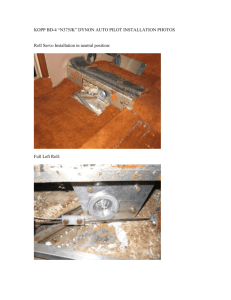
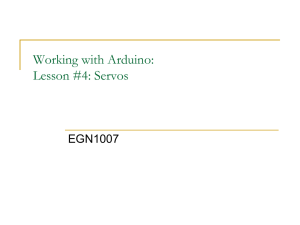


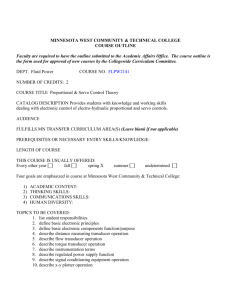
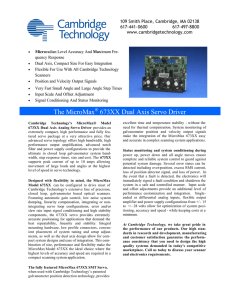
![Machine Elements [Opens in New Window]](http://s3.studylib.net/store/data/009054465_1-76bd66345967cd60934cd86eccae6fad-300x300.png)
